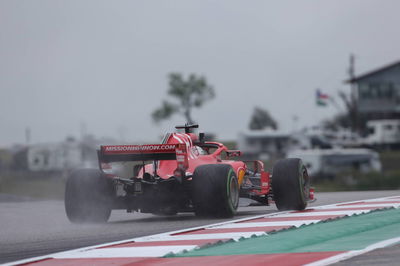FIA explains Vettel penalty for F1 red flag rule breach
Formula 1 race director Charlie Whiting has moved to clarify the FIA’s standing over red flag rules and explained why Sebastian Vettel was penalised at the United States Grand Prix.
Vettel received a three-place grid penalty in Austin after he failed to slow sufficiently when a red flag was thrown following Charles Leclerc’s spin during opening practice on Friday.

Formula 1 race director Charlie Whiting has moved to clarify the FIA’s standing over red flag rules and explained why Sebastian Vettel was penalised at the United States Grand Prix.
Vettel received a three-place grid penalty in Austin after he failed to slow sufficiently when a red flag was thrown following Charles Leclerc’s spin during opening practice on Friday.
The Ferrari driver was adamant he had slowed down enough but data from his car showed he had been speeding. Whiting believes the approach to red-flag rules is “logical”, adding Vettel simply “didn’t do a good enough job”.
“I think it’s a perfectly logical approach because there was no principle requirement to say exactly how much you would slow down when a red flag was given, which seemed at odds with having to do it when a Safety Car or VSC is out,” Whiting explained.
"It was a logical thing to do, the teams felt, to use exactly the same system for a red flag. We've had three cases now where drivers have failed to stick to that.
"One of them was a mistake from a driver who admitted what he'd done, that was Daniel [Ricciardo] in Australia. Esteban [Ocon] was in Suzuka and Seb this time.
"I don't know exactly what they did or why they didn't adhere to the delta time but they seem to manage it perfectly well when the safety car or VSC is out.
"So, I don't know whether it's a matter of whether drivers don't remember, perhaps. It's pretty clear, as every light panel is showing bright red.
“It's not as if you can actually miss it. But he did. He didn't do a good enough job on that particular occasion."
Vettel said he wanted a “common sense” approach applied to each separate incident, while a number of drivers backed the German and called the penalty “harsh”.
But Whiting feels the decision to hand Daniel Ricciardo a three-place grid penalty - instead of a five-place penalty referred to in the FIA guidelines for red flag breaches - for a similar offence in Australia set a precedent.
"I think it is better to have the hard and fast rule because we are continually asked how much they have to slow down," he added.
"So, it's like with more or less everything the teams do with the cars. They want to know how far they can push it.
"It's a clear limit and it's an easy thing to follow. I just think it was a driver mistake. If someone doesn't slow down for a red flag it's serious.
“When you look at it in the cold light of day it is a bad thing not to slow down enough for a red flag, however you dress it up."












